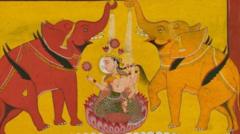The British Museum in London is currently hosting an enchanting exhibition titled "Ancient India: Living Traditions," which meticulously showcases the evolution of spiritual art across the Indian subcontinent. Featuring 189 significant artifacts that span over two millennia, this exhibition invites visitors on a visual journey exploring ancient sculptures, paintings, and manuscripts that express India's rich spiritual heritage.
The transformation of artistic representations from 200 BC to AD 600 reveals a significant shift in how gods, goddesses, and enlightened figures of Hinduism, Buddhism, and Jainism were depicted. Initially rooted in symbolic imagery, these representations transitioned toward a more humanized form, reflecting profound cultural and spiritual developments. Sushma Jansari, the exhibition's curator, notes, "Today we can't imagine the veneration of Hindu, Jain or Buddhist divine spirits or deities without a human form, can we?"
Visitors can engage with the exhibition through five distinct sections. These sections delve into the origins of nature spirits, religious narratives across the three traditions, and the subsequent dissemination of these artistic forms beyond India to regions like Cambodia and China.
One striking centerpiece of the Buddhist section—a sandstone panel—demonstrates this fascinating transformation, with one side depicting the Buddha in human form around AD 250, while an earlier depiction showcases symbolic elements representing the Buddha from around 50-1 BC. "To have this transformation showcased on one single panel from one single shrine is quite extraordinary,” remarks Jansari.
In addition to Buddhist art, early bronze statues and stone carvings representing Hindu goddesses and Jain enlightened teachers, or tirthankaras, reveal the evolution of sacred imagery. Curators emphasize the interconnectedness of artistic traditions across faiths, illustrating how workshops in the ancient city of Mathura produced similar designs, made under shared cultural influences.
What's unique about this exhibition is its presentation of all three religious artistic traditions together, rather than in isolation. Additionally, the exhibition thoughtfully communicates the provenance of each item, drawing attention to their journeys through history and the presence of female donors within Buddhist art.
The exhibition is designed to engage the senses through scents, fabric textures, nature sounds, and vibrant colors, evoking the atmosphere of active religious spaces. "There's so much going on in these sacred spaces, and yet there's an innate calm and serenity. I wanted to bring that out," says Jansari regarding her collaboration with designers and artists.
Projected film screens displaying worshippers further connect the ancient to the contemporary, underscoring that this artistic evolution reflects living traditions that remain vital to millions globally.
"Ancient India: Living Traditions" runs from May 22 to October 19 at the British Museum, accompanied by a collection that integrates loans from 37 museums and libraries around the world. This exhibition not only celebrates the artistic journey of India but also highlights the enduring legacy and relevance of these spiritual expressions.



















